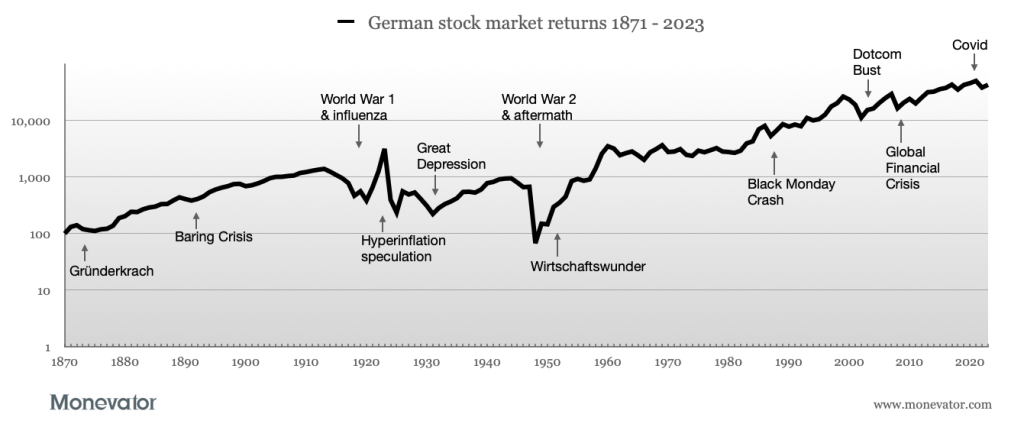
Bertie ‘The Investor’ Wooster settled into his comfy and ever-motivating armchair at the aptly-named Drones Club and began one of his infamous monologues…
Alright Biffy? How about a tale from mine youth? From back when I learned the great unwashed were all agog over Premium Bonds, the state-sponsored gambling racket run by National Savings & Investments (NS&I).
Now, you know I’m a contrary so-and-so. But even as a pallid stripling in my third decade I was aghast to discover I’d been eschewing Britain’s most popular savings product.
Had I missed a trick?
Am I missing one now?
Well that depends, as we shall see.
Either way, the billions of postponed daydreams the masses have stashed in Premium Bonds – £121 billion, as of the latest count – make them the nation’s favourite way to save, according to The Telegraph.
Yet for most of my adult life, Premium Bonds were a joke among the investing cognoscenti I pow-wowed with over Mai Tais in Mayfair.
Something bought by maiden aunts overdue some luck, or given to unlucky grandchildren who’d have been better-off with envelopes stuffed with cash.
Premium Bonds are odd(s) investments
Indeed as my top pals Boffo the banker and Over Easy the currency trader would banter across the billiards table, in those days only a fool would buy Premium Bonds for the chance to win a million.
“If you must be an insufferable member of the lottery punting hoi polloi…” would chirp in Erinaceous the hedge fund manager, from atop the club’s antique rocking horse, “…then put your money into a savings account and buy National Lottery tickets with the interest. The odds of hitting the big one are far higher.”
Wise words old sport!
Because what really baffled the old bonce about Premium Bonds back then was how little the blighters actually did for your wealth.
In those halcyon times – around the turn of the century – it was easy to get 5% interest on cash. Much more if you were savvy.
In contrast, the effective interest rate on Premium Bonds with average luck was in those days far lower.
Put a few bags of sand into Premium Bonds, and you gave up a stream of interest income that you could have put to a nobler use. Like punting on the nation’s favourite weekly sweepstake, par exemple.
National Lottery tickets only cost a quid then1. Every week you could buy dozens with the interest on your cash, chance your arm on the Lotto’s superior odds – and still make it to Rules for teatime.
But, of course, those dreamy days did not last forever.
Following some less-than-stellar moves by friend Boffo and his mob, the financial system turned queasy in 2008. Interest rates were duly savaged by the pink-hued rascals at the Bank of England – thoroughly filleting the spread between the misery return from Premium Bonds and what you could get from Captain Mainwairing at the bank.
Which for a while actually made Premium Bonds competitive on their own merits – especially if you were a higher-rate taxpayer.
Strange times those were.
Which brings me to… now.
Premium Bonds: interesting again
After near-abolishing the notion of making a few pennies on one’s hard-earned by cutting rates to near-0% for a decade, the brain trust of Threadneedle Street has been hiking rates for more than a year.
Indeed Bank Rate is now a chunky 5.25%.
High Street banks have followed suit. So it’s easy today to score 5% or more on your cash – and better-than 6% if you push the operation like a barrow-boy on the make.
But have these higher rates on cash kicked Premium Bonds back into the long grass?
Well – lean in chums – not exactly.
Because seemingly keen to hasten Albion’s descent into a nation of perfidious gamblers, the gang at NS&I have made Premium Bonds more generous too.
Indeed they are now paying out very nearly 5% a year in prizes.
The number of jackpots was doubled a few years ago too, to – well – two. Not amazing, but that’s still two chances to top-up the old trust fund with a £1m bag of swag.
Consider me roused. Piqued, even!
I mean, I may be the sort of absent-minded chump who leaves his Estonian beauty queen bride on the tarmac at the airport on our honeymoon because I mistook her for a shop mannequin.
But I’m not one to turn his nose up at a penny-compounding wheeze – not without a closer inspection!
Time to look at Premium Bonds with fresh eyes.
What are Premium Bonds?
Given there’s 121-thousand million pounds invested in Premium Bonds, a majority of Monevator readers will surely own a few – and already know as much about them as I do.
Hence my picaresque introduction, which no doubt has P.G. Wodehouse turning in his grave. (We’ll leave Bertie W. in peaceful repose here).
More prosaically:
Premium Bonds are a special savings fund administered by NS&I on behalf of the British government. (Note: they are not ‘bonds‘ as professional investors use the term).
Premium Bonds are backed by the government. This means your capital is not at risk from bank runs. (But remember all regulated savings accounts are protected up to £85,000 by the FSCS).
You can sell Premium Bonds at any time. According to NS&I it can take up to eight working days until you the money reaches your bank. That makes them fairly liquid, but not quite instant access.
Premium Bonds are a form of lottery bond, costing £1 each. The minimum tranche is £25. You do not ‘spend’ these bonds to take part in the lottery. Rather, they stay in your account until you withdraw them, like with cash savings.
The maximum holding of Premium Bonds for any one individual is £50,000. This limit has been frozen since 2015.
The effective interest rate on the £121 billion the nation has socked away in Premium Bonds is currently 4.65%.
However the bonds do not pay interest. Instead every bond enters a monthly prize draw for cash prizes. These range from small and far more common prizes of £25 to £100, up to £1 million.
NS&I says the odds of winning a prize per £1 bond in any given month is currently 21,000 to 1.
Winnings are tax-free.
The bonds were introduced in 1956, and today 24 million – or roughly one in three – Britons owns at least a few. A dedicated machine called ERNIE supposedly draws the prizes. There have been 649 million prizes since launch. They add up to a staggering £27.7 billion in total.
If you’re easily seduced, you can tootle off and buy some Premium Bonds online from NS&I.
How the Premium Bond prize money is divided up
Still here? I’m glad to see you’re not a sucker for any old 21,000:1 odds.
The next thing to understand is the nature of the Premium Bonds prize draw. This varies depending upon, for example, how many bonds are in issue.
Here’s the October 2023 prize draw breakdown:
Prize band
Prize value
Number of prizes
Higher value (10% of prize fund)
£1 million
2
£100,000
90
£50,000
181
£25,000
360
£10,000
902
£5,000
1,803
Medium value (10% of prize fund)
£1,000
18,834
£500
56,502
Lower value (80% of prize fund)
£100
2,339,946
£50
2,339,946
£25
1,027,651
Totals for October 2023
£470,853,175
5,786,217
Source: NS&I
The first thing to note is there are vastly more small prizes than large prizes.
A whopping 80% of the prize pool is allocated to prizes of £100 or less. Or, looking at the individual lines, there are only 181 prizes of £50,000 versus well over two million £100 prizes.
This skewed distribution clearly boosts the ‘savings pot’ credentials of Premium Bonds.
Why? Well, to give an extreme counter-example, imagine if the £471 million prize pot was awarded to just one winning bond in October. For all other bond holders, the interest rate that month would be 0%.
Conversely, if the whole prize fund was distributed ‘fairly’ across each individual bond, then Premium Bonds would be just like a bank account in delivering a set interest rate. Not a lottery at all.
As things stand, however, Premium Bonds are a bit of both.
There are enough small prizes to ensure that anyone with a reasonably big holding will probably win at least a few times over the year. But there is the tantalising prospect of a big win, too.
This asymmetrical distribution is why it’s so hard to calculate the precise odds with Premium Bonds.
More big prizes nowadays
Incidentally, the allocation of the prize fund has changed quite a bit over the past decade.
Most eye-catching – there are those two £1m jackpots a month.
More meaningfully, as I showed above today 20% of the fund is split across the two larger prize bands, with 80% allocated to small prizes. A decade ago, only 5% of the fund was allocated to the highest prize band, and 4% to the medium value one. Some 91% went towards smaller prizes.
I don’t recall why NS&I made this change. Perhaps it felt a 10/10/80 distribution was easier to understand? (Premium Bonds are plagued by conspiracy theories.) Or maybe it wanted to more sharply distinguish Premium Bonds from conventional savings?
The cynic in me says someone did some game theory to determine what sucked the most money in.
On that note, there’s also far more money in Premium Bonds today. That’s another reason why there are so many more individual prizes than years ago.
Back in February 2014, for instance, the prize fund was only £51m.
And just 61 people won a £5,000 prize in February 2014, compared to 1,803 in October 2023.
What are the chances of winning with Premium Bonds?
Good question. And one that’s far harder to answer than you might presume.
A few years ago Martin Lewis of Money Saving Expert semi-famously employed a cosmologist to do the multinomial probability maths needed to solve the Premium Bond prize riddle.
The result was his Premium Bonds Odds Probability Calculator. Lewis claimed this ran for six hours every month to calculate the latest odds.
With it you could see how much you might expect to win with average luck and owning a certain amount of Premium Bonds over one to ten years.
It was nice to play with. But rather than for determining your likely – but still uncertain – return, the tool was most useful for getting a feel for the shape of the probabilities.
For example:
Most smaller Bond holdings (say £1,000) will win nothing in a typical year.
To maximise your chances of a smoothed savings-like return, you need to hold a full £50,000 allocation.
The odds of winning one of the two £1 million jackpot for any individual bond is about one in 60 billion.2.
Unfortunately the Money Saving Expert calculator is currently broken. It’s apparently giving the wrong odds, and has done so for a while.
That the calculator hasn’t been fixed in day or two is a clue as to how thorny the maths is!
Median expectations
Whether they’re maths genius cosmologists or not, people get into big arguments about the expected rate of return from Premium Bonds.
Some insist that the prize fund rate is the expected return. They claim any talk about expecting any other return is hocus-pocus.
But this is to misunderstand how probability works.
It’s true that the expected rate of return on the £121bn of Premium Bonds in issue is currently 4.65% – the prize fund rate set by NS&I.
But to guarantee achieving this exact return, you’d need to own all of the Premium Bonds.
And even if you were a multi-billionaire baller and so minded to do so, you’d be scuppered by the £50,000 maximum holding size.
So in practice everyone owns only a sliver of the Premium Bonds out there. And each bond they own is a shot at winning one of those prizes in the table above.
Mr Average is not so lucky
The overwhelming majority of individual bonds will win nothing in any given month.
But what is the expected return for a particular bond owner – who will certainly own more than one Premium Bond?3
Well, in the absence of Lewis’ calculator, your maths guess is good as mine.
However it’s certainly less than the prize fund rate.
To see that, recall that only two bonds will win £1m in a month.
For those individual bonds, the realised return is through the roof! A £1 investment has turned into £1m, over some period of time.
But for those two lucky jackpot winners to get their £2m, every other bond must earn a lower return.
The prize fund is smaller by a meaningful £2m.
But the remaining bond pool is down by only two bonds.
True, this won’t reduce the expected rate by much – it would still round up to 4.65% or so.
But you’ll recall that 20% of the prizes are in the medium and higher value category. And those chunkier prizes are won by very few bonds – just 78,674 in October, according to the table above, out of 121-odd billion.
Even for the smaller prizes, only a tiny fraction of the total bonds in issue will win anything.
Set against all that, we normally talk of interest or returns over a year. Your bonds go into the draw every month – so that’s 12 times a year when each of your bonds might win £25 or more.
Finally, as already stated, the more bonds you own the more likely you are to get ‘average’ luck.
Own just one bond4 and you can’t expect to win in your lifetime or the next. But with £50,000 you will probably get something close to the prize fund rate.
Crunch all the numbers and the typical expected return – the so-called Median return, enjoyed by an average Premium Bond holder with average luck – will be much less than the expected return.
How much do you have? Size matters
The exact expected median return will change every month as the prize fund rate changes.
But to give you a feel for the difference, some actuaries did the sums in August 2023 when the prize fund rate was increased from 3.7% to 4%.
Here’s what they calculated:
The numbers going forward will be different again with a 4.65% prize fund rate at the time of writing – higher, obviously – but you get the idea.
Remember, it’s the skewed nature of the prize fund that results in the ‘lost’ interest here for a median bond holder. Which is what makes Premium Bonds a lottery of course.
Incidentally, statisticians have studied exactly why this distribution – especially the relatively big weighting to lower-probability, higher-value prizes – makes Premium Bonds so popular with savers.
But you don’t need to be an academic to understand the dream of winning big.
Premium Bonds versus the National Lottery
On that note, how does the Lotto compare?
Well, the odds of matching all six numbers in the National Lottery are about one in 45 million. (They rose from one in 14 million with the addition of ten more balls in 2015.)
In contrast, the odds of winning the £1m jackpot with Premium Bonds is about one in 60 billion.
Yes, that’s ‘illion’ with a ‘B’.
For what it’s worth lottery tickets cost £2. Whereas a single Premium Bond ‘ticket’ is just £1.
But that doesn’t change the magnitude of the odds difference much when you’re pitting millions against billions. You’re clearly far more likely to win the jackpot on any single draw of the lottery, compared to with Premium Bonds.
However that’s not the end of the story.
With the National Lottery, your money is gone after each draw. With Premium Bonds, you get another chance next month. In perpetuity.
On the other hand the Lottery jackpots can be far higher than £1 million.
Got a third hand? Then consider that the Lottery win might also be shared.
Jackpots aside, the National Lottery is a terrible bet. Only about 50% of the money is returned as prizes.
That means the expected return for all Lottery ticket buyers is negative 50%, versus the positive 4.65% from Premium Bonds. And nearly all Lottery ticket buyers will win nothing.
Premium Bonds and inflation
Remember that Premium Bonds are not inflation-proofed, so a £1 bond will become less valuable in real terms over time.
You’d have to reinvest your prize money to try to keep up with inflation.
You can reinvest your winnings automatically via NS&I, but only up the maximum holding of £50,000. Once you’re full up, you must redirect any future winnings to an alternative account.
At the time of writing inflation is much higher than the prize fund rate on Premium Bonds – let alone the lower median expected rate.
Your Premium Bond holding will probably decrease in value in real terms for as long as this persists.
Incidentally I suspect inflation is a big reason behind the persistent myth that long-owned older bonds win much less often than newly-purchased bonds.
Somebody’s £100 Premium Bond holding was a sizeable stash in the 1970s. But if it’s never been added to then it’s not worth much now. Just a few pizzas.
Such a tiny holding is now unlikely to win for years on end, if ever. Inflation has reduced its real terms value – and the proportionate share of a £100 holding versus a £121 billion pot.
Premium bonds and your tax bracket
There’s one more thing to consider, which is your tax bracket.
Remember that Premium Bond winnings are tax-free. This makes them intrinsically more valuable to a higher-rate taxpayer than a basic rate payer – let alone to somebody who pays no tax.
You might get just over 5% interest on the best instant access savings accounts right now. That’s obviously decently higher than the 4.65% prize fund rate with Premium Bonds.
So you should prefer cash over Premium Bonds, right – far-fetched £1m jackpot opportunities aside?
Perhaps, but remember you may be liable to pay tax on your 5% interest from cash – once you’re earning above your personal savings allowance.
For a higher-rate taxpayer, for example, a cash savings pot of more than £10,000 earning 5% or higher interest would already take some of your interest income above your meagre allowance of £500.
Additional-rate payers have it worse. They get a zero savings allowance!
In contrast basic-rate taxpayers can earn £1,000 in interest before being taxed.
Tax on savings income reduces your effective interest rate
For a higher-rate taxpayer, the tax deducted from interest income above the £500 allowance essentially reduces your interest rate by 40%, if you’re comparing it to a tax-free income.
So a seemingly juicy 5% rate is now just 3%. That is well below the current prize fund rate from Premium Bonds.
Even basic-rate taxpayers will see the effective post-tax interest rate fall to 4%. Which again is less than the 4.65% payout touted by NS&I’s lottery bonds.
And as always with our stupidly complicated tax system, complications abound.
For example, if you’re living off savings and your other income is below a set threshold, you can earn far more from savings before you’re taxed.
At-a-glance guide to how tax impacts returns
Broadly speaking though, here’s how the Premium Bond prize fund rate compares to a variety of cash-like options:
Product
No tax
Basic-rate
taxpayer
Higher-rate
taxpayer
Additional
rate payer
Premium Bonds*
4.65%
4.65%
4.65%
4.65%
5% instant access
5%
4.0%
3.0%
2.75%
6% one-year fixed
6%
4.8%
3.6%
3.3%
Top Cash ISA
5%
5%
5%
5%
Repay mortgage
Mortgage
rate
Mortgage
rate
Mortgage
rate
Mortgage
rate
*As discussed above, the 4.65% rate in the table is the prize fund rate across all Premium Bond holders. You’re probably going to earn less than this, with average luck.
These specific rates will all date pretty quickly. But the takeaway is clear.
As always, fill your ISA allowance first. And after that, perhaps consider pension contributions. You could put the pension contributions into a money market fund in your SIPP if you want to keep it in cash.
Still have cash to spare?
I’d favour conventional savings accounts until you exhaust your personal allowance. You may as well take advantage of the tax break. Buy a national lottery ticket every week if you must have some excitement.
But for savings income earned above your personal allowance, Premium Bonds do look attractive.
If you’re in the higher tax bands, they may look like a no-brainer. But please do remember, again, that their return is not guaranteed. It’s literally a lottery!
In complete contrast, paying off your mortgage is a certain return. If you’ve just remortgaged on to say a 6% fixed rate, then you’re getting effectively a 6% tax-free return when you pay some of it down.
That’s very attractive. Although it’s not quite like-for-like, in that by paying down your mortgage you’re effectively locking that money away.5
Are Premium Bonds worth it?
Unfortunately, with Mr. Lewis’ calculator broken and neither an actuary or a crystal ball to hand, it’s hard for me to be sure if Premium Bonds are worth it even for myself.
Your exact circumstances will be different again – in terms of your tax bracket, your other income, and exactly how much you would have in Premium Bonds, which goes a long way to determining your expected return.
As a rough guide though, you might knock 0.5% off the prize fund rate to think about your expected return with a full £50,000 holding.
Increase this discount if you hold fewer bonds, as seen in the results from the actuarial maths above.
You might deduct 1% from the prize fund rate if you only hold £5,000, for instance.
Happy go lucky saving
So do these median expected return rates – from 4.15% to 3.65% say – make sense?
Perhaps, as per the post-tax return table above. But remember, again, that luck will loom large.
For higher-rate tax payers with £50,000 to put away who’ve already filled their ISAs and used up their savings allowance with cash savings elsewhere, I’d say Premium Bonds look a decent bet.
You might expect (but not assume) you will get 4% or so from Premium Bonds today, versus just 3% after tax on cash.
However this advantage diminishes at lower tax brackets.
Ironically, the legions of pensioners who own small amounts of Premium Bonds and have low incomes would probably be better off swapping them for cash savings. (Assuming the resultant interest didn’t change their tax bracket).
Finally, don’t be a conspiracy theorist about whether Premium Bonds are a good investment. The myths and inconsistencies arise from probability. Unless you believe the Government is into explicit fraud.
Premium Bonds are a lottery. If you want a sure thing, buy a gilt!
Note: Comments below might refer to an older version of this article. We last asked whether Premium Bonds are a good investment in 2014! So some things will have changed.
£2 today.Remember there are two jackpots and roughly £121 billion in Premium Bonds. Individual bonds costing £1Remember: The minimum holding size is £25.Again, the minimum is 25, or £25 worth.Unless you have an offset mortgage where you can easily withdraw it again if needed.
The post Are Premium Bonds a good investment? appeared first on Monevator.



